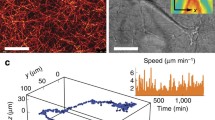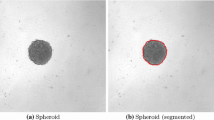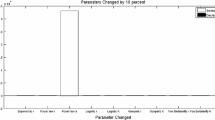Abstract
Analysis of tumour growth is required to investigate the biology of tumours and to determine the effects of new anti-tumour therapies. A non-parametric mathematical method for the analysis of a set of experimental tumour growth data is described. The method is based on the similarity between time series of tumour size measurements (e.g. tumour volume), similarity being defined as the Euclidean distance between data measured for each tumour at the same time. Subsets of similar time series are found for a given population of tumours. A biologically meaningful parameter H has been derived which is a measure of the scattering of experimental volume samples. The method has been applied to the analysis of the growth of (i) untreated multicellular tumour spheroids obtained with different cell lines and (ii) spheroids, treated with cytotoxic drugs (immunotoxins). Results are compared with those previously obtained by applying the classical Gompertz growth model to the analysis of treated and untreated spheroids.
Similar content being viewed by others
References
Brunton, G. F. andWheldon, T. E. (1980): ‘The Gompertz equation and the construction of tumor growth curves’,Cell. Tissue Kinetics,13, pp. 455–460
Chignola, R., Foroni, R., Candiani, C., Franceschi, A., Pasti, M., Stevanoni, G., Anselmi, C., Tridente, G. andColombatti, M. (1994): ‘Cytoreductive effects of anti-transferrin receptor immunotoxins in a multicellular tumor spheroid model’,Int. J. Cancer,57, pp. 268–274
Chignola, R., Foroni, R., Franceschi, A., Pasti, M., Candiani, C., Anselmi, C., Fracasso, G., Tridente, G., andColombatti, M. (1995): ‘Heterogeneous response of multicellular tumour spheroids to immunotoxins and ricin toxin’,Br. J. Cancer,72, pp. 607–614
Chignola, R., Liberati, D., Chiesa, E., Foroni, R., Andrighetto, G., Tridente, G. andColombatti, M. (1998): ‘On the growth dynamics of multicellular tumor spheroids: a preliminar report’,in Marsella Guindani, F. andSalvadori, G. (Eds.): ‘Chaos, fractals and models’ (Gianni Iuculano Editore, Italian University, Press, Pavia, Italy), pp. 371–377
Chignola, R., Schenetti, A., Chiesa, E., Foroni, R., Sartoris, S., Brendolan, A., Tridente, G., Andrighetto, G. andLiberati, D. (1999): ‘Oscillating growth patterns of multicellular tumour spheroids’,Cell Prolif.,32, pp. 39–48
Demicheli, R. (1980): ‘Growth of testicular neoplasm lung metastases: tumor specific relation between two gompertzian parameters’,Eur. J. Cancer,16, pp. 1603–1608
Demicheli, R., Foroni, R., Ingrosso, A., Pratesi, G., Soranzo, C. andTortoreto, M. (1989): ‘An exponential-gompertzian description of LoVo cell tumor growth from in vivo and in vitro data’,Cancer Res.,49, pp. 6543–6546
Durand, R. E. (1981): ‘Flow cytometry studies of intracellular adriamycin in multicell spheroids in vitro’,Cancer Res.,41, pp. 3495–3498
Laird, A. K. (1964): ‘Dynamics of tumor growth’,Br. J. Cancer,18, pp. 490–502
Norton, L., Simon, R., Brereton, H. D. andBogden, A. E. (1976): ‘Predicting the course of Gompertzian growth’,Nature,264, pp. 542–545
Norton, L. (1985): ‘Implications of kinetic heterogeneity in clinical oncology’,Semin. Oncol.,12, pp. 231–249
Rofstad, E. K. andSutherland, R. M. (1989): ‘Growth and radiation sensitivity of the MLS human ovarian carcinoma cell line as multicellular tumor spheroids and xenografted tumors’,Br. J. Cancer,59, pp. 28–35
Steeg, P. S., Alley, M. C. andGrever, M. R. (1994): ‘An added dimension: will three-dimensional cultures improve our understanding of drug resistance?’,J. National Cancer Inst.,86, pp. 953–955
Sutherland, R. M. (1988): ‘Cell and environment interactions in tumor microregions: the multicell tumor spheroid model’,Science,240, pp. 177–184
Twentyman, P. R. (1980): ‘Response to chemotherapy of EMT6 spheroids as measured by growth delay and cell survival’,Br. J. Cancer,42, pp. 297–304
Vitetta, E. S., Thorpe, P. E. andUhr, J. W. (1993): ‘Immunotoxins: magic bullets or misguided missiles?’,Immunol. Today,14, pp. 252–259
Author information
Authors and Affiliations
Corresponding author
Rights and permissions
About this article
Cite this article
Chignola, R., Liberati, D., Chiesa, E. et al. A non-parametric method for the analysis of experimental tumour growth data. Med. Biol. Eng. Comput. 37, 537–542 (1999). https://doi.org/10.1007/BF02513343
Received:
Issue Date:
DOI: https://doi.org/10.1007/BF02513343




